Introduction
Importance of Lighting in Photography: In the realm of photography, lighting plays an indispensable role in shaping the quality and mood of an image. Mastering lighting techniques can distinguish a good photograph from a great one, transforming ordinary scenes into extraordinary visuals. In this comprehensive guide, we delve into the various facets of lighting, its significance, and how photographers can harness its power to enhance their craft.
Importance of Lighting in Photography
Creating Mood and Atmosphere
Lighting is a powerful tool that can evoke emotions and set the tone of a photograph. Whether it’s the soft, warm glow of a sunset or the stark, harsh light of midday sun, the quality and direction of light profoundly affect the mood. For instance, soft, diffused light from an overcast sky creates a calm, serene atmosphere, ideal for portraits and nature photography. Conversely, dramatic shadows and high contrast from directional light can add intensity and drama, perfect for architectural and street photography.
Enhancing Texture and Detail
Good lighting reveals the intricate details and textures of subjects. Side lighting, where light hits the subject from an angle, is particularly effective in highlighting textures. This technique brings out the fine details in landscapes, fabrics, and human skin, adding depth and dimension to the photograph. In product photography, precise lighting can accentuate the features of a product, making it more appealing and lifelike.
Defining Shape and Form
Lighting is crucial in defining the shape and form of subjects. By strategically placing light sources, photographers can sculpt their subjects, creating three-dimensionality on a two-dimensional plane. For example, rim lighting, where light outlines the edges of a subject, separates it from the background, adding a sense of depth and focus. This is especially useful in portrait and wildlife photography, where the subject stands out prominently against a blurred backdrop.
Types of Lighting in Photography
Natural Lighting
Natural lighting, provided by the sun, is one of the most commonly used light sources in photography. Its quality and direction change throughout the day, offering a wide range of creative possibilities.
- Golden Hour: Occurs shortly after sunrise and before sunset, when the sun is low on the horizon, casting a warm, golden hue. This time is ideal for portraits and landscapes, as the light is soft and flattering.
- Blue Hour: The period just before sunrise and after sunset, characterized by a soft, cool light. It’s perfect for capturing serene, tranquil scenes and cityscapes.
- Midday Light: While often harsh and unflattering, midday light can be used creatively to produce high-contrast images with strong shadows, adding a dynamic quality to the photograph.
Artificial Lighting
Artificial lighting provides photographers with greater control over their lighting environment. It includes a variety of light sources, each with its own characteristics and uses.
- Continuous Lighting: These are constant light sources such as LEDs and fluorescent lights. They are useful for both photography and videography, allowing photographers to see how light falls on their subjects in real-time.
- Strobe Lighting: Also known as flash, strobe lighting provides powerful bursts of light. It’s highly versatile and can be modified with diffusers, reflectors, and softboxes to achieve the desired effect.
- Studio Lighting: Studio setups often include multiple light sources and modifiers to create controlled lighting environments. Techniques such as three-point lighting (key light, fill light, and back light) are standard practices in portrait and product photography.
Lighting Techniques and Tips
Understanding Light Direction and Quality
- Front Lighting: Light that hits the subject from the front reduces shadows and creates a flat image. It’s ideal for minimizing textures and imperfections.
- Side Lighting: Light that strikes the subject from the side enhances textures and details, adding depth and dimension.
- Back Lighting: Light coming from behind the subject creates a silhouette effect, useful for dramatic and artistic shots.
- Diffused Light: Soft, spread-out light that reduces harsh shadows. It can be achieved using softboxes, diffusers, or shooting in shaded areas.
Using Reflectors and Diffusers
Reflectors and diffusers are essential tools for managing light in photography. Reflectors bounce light back onto the subject, filling in shadows and adding highlights. They come in various colors (white, silver, gold) to achieve different effects. Diffusers soften harsh light, creating a more flattering and even illumination. They are particularly useful in portrait and macro photography, where gentle lighting is crucial. Importance of Lighting in Photography
Balancing Natural and Artificial Light
Balancing natural and artificial light involves blending these sources to achieve a harmonious look. This technique is often used in indoor photography, where ambient light is supplemented with artificial light to create a balanced exposure. Photographers must be mindful of the color temperature of different light sources to ensure consistent and natural-looking results.
Common Lighting Mistakes and How to Avoid Them
Harsh Shadows and Overexposure
Harsh shadows and overexposure can ruin an otherwise good photograph. To avoid this, photographers should use diffusers to soften the light and reflectors to fill in shadows. Properly metering the light and adjusting the exposure settings are crucial steps in achieving balanced lighting. Importance of Lighting in Photography
Mixed Lighting Color Temperatures
Different light sources have varying color temperatures, which can result in mixed lighting and color casts. Photographers should strive to use light sources with similar color temperatures or correct the white balance in post-processing to ensure consistent colors. Importance of Lighting in Photography
Ignoring Ambient Light
Importance of Lighting in Photography: Ambient light, the existing light in a scene, should not be ignored. It can add depth and context to a photograph. Balancing ambient light with additional lighting requires careful consideration of the overall exposure and the desired effect.Importance of Lighting in Photography
Conclusion of Importance of Lighting in Photography
Importance of Lighting in Photography : Lighting is the cornerstone of effective photography. By understanding and mastering various lighting techniques, photographers can significantly enhance the quality of their images, creating compelling and visually stunning photographs. Importance of Lighting in Photography. From setting the mood and revealing textures to defining shapes and balancing light sources, the art of lighting is essential for capturing the essence of any subject.Importance of Lighting in Photography
Also Checkout These
- Top 10 Photography Trends to Watch in 2024
- 750+ Mahadev Dp, Images, Wallpapers, hd 4k
- 500+ HD Shree Ram photos Download Now for Wallpapers,DP
Our Business Portal Click Here

